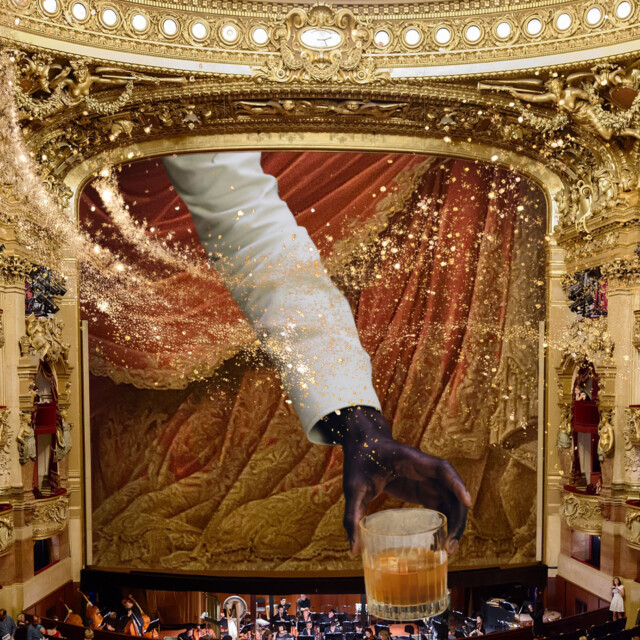At the world’s best bar, there is no bar.
Sips in Barcelona is the reigning kingpin of the World’s 50 Best Bars, and anyone who’s been inside — they’ll vouch for me on this, I swear — can confirm that within that bar, there is very much no bar. Rather than asking about trees falling in forests and whether or not anyone was there to hear it, we should be holding philosophical discourse on whether or not a bar without a bar is even a bar.
The whole idea of the bar isn’t just the place where everybody knows your name, but also the definitive, ingrained setting at which that welcoming encounter occurs — a long countertop lined with stools with customers on one side and the bartender on the other. From your perch, you can view the rows of spirits and selection of beers available, engage the bartender in a bit of banter, and embark on a conversation with a stranger on either side of you.
Such quaint notions are being tossed aside, though. There are bars with no bars, back bars with no bottles, and bartenders who don’t make any drinks — not in front of you à la minute, at least. Instead, there are bar carts and kitchen counters, as well as feature-rich work stations that seem like they were designed by NASA. In a cocktailing world where rotovaps, fat washing, tricked out ice in dozens of shapes and sizes, and specific glassware for every drink on the menu are the norm, did we really expect the notion of the bar itself to realm static?
Flipping the Bar Script
At Sips, once guests make their way to the front of the line that has probably accrued outside, they enter a space with bottle shelving on one wall and a row of tables on the other. A smattering of other tables are placed in between, among a bar cart workstation with a crew of bartenders working around it from multiple angles.
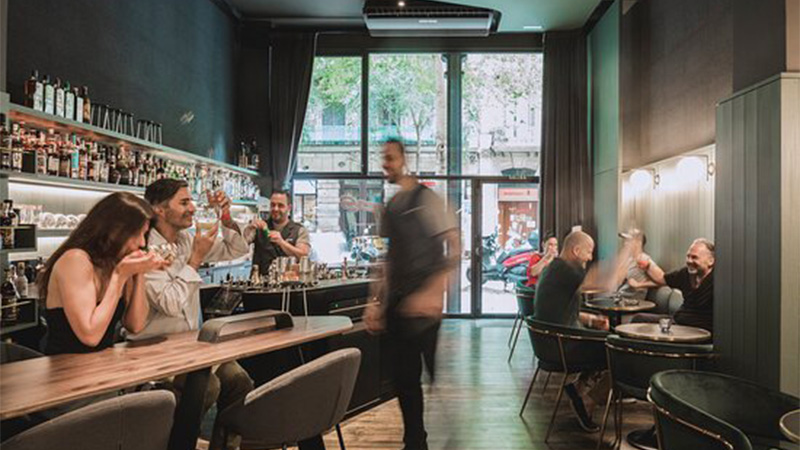
“The idea was to find a way to have a more open and flexible flow of work at the bar while avoiding the barrier of a bar counter,” says co-founder Simone Caporale. “The beauty was to find out that people trusted us fully the moment they stepped in. It was a rewarding feeling.”
While most standard bar carts could be repositioned around a room, at Sips it’s stationary. “It looks mobile but it doesn’t move,” says co-founder Marc Álvarez.
“Every day we have a guest ask us if it moves or not,” he says. “Sometimes they try to push it, checking if there are any wheels. … It’s crazy to see how a bar can evoke such technical curiosity among the guests!” But of course, when your bar doesn’t have a bar, curiosity is bound to ensue.
The bar without a bar creates a different dynamic for guests, particularly solo visitors. With no bar counter, individual guests are placed at larger, communal tables with other guests. “It creates eye contact with everyone in the room,” Álvarez says. “You’ll never feel alone as nobody is staring at the bottle shelves.”
Sips isn’t the only establishment challenging the notion of what a bar is in terms of where and how bartenders are working, and where and how guests are seated. At Kwãnt in London, the bar is more akin to a chef’s table — dubbed the bartender’s table — with cocktail stations on three sides and guests seated at the front, immersed in the action.
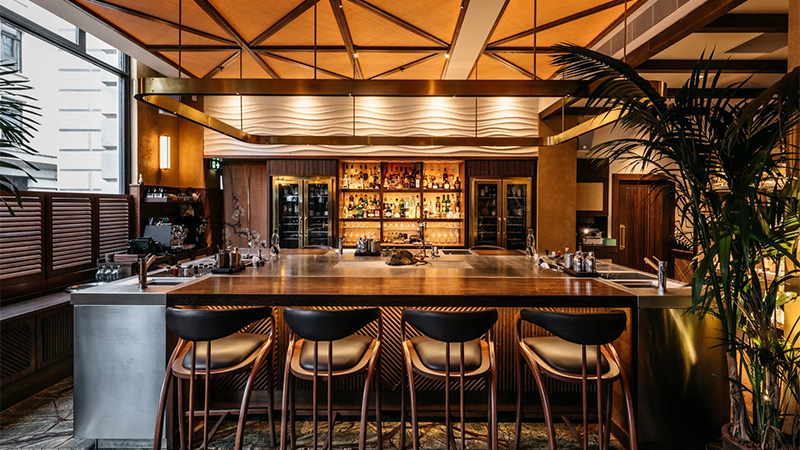
At A Bar With Shapes for a Name, also in London, the Bauhaus movement inspires its quest to match style with form, artistic beauty with utility. The bar, as it were, is more like a seat in a home’s kitchen in front of wooden cabinetry hiding away what would normally be found on a back bar or work station, alongside large, stainless-steel refrigerators. Drinks are batched using house-made distillates, so there’s no mixing being done and neither branded bottles nor cocktail tools to be found. Glassware pre-loaded with fanciful ice is kept queued up in the freezer, and cocktails are dispensed from portioned-out, hand-painted bottles.
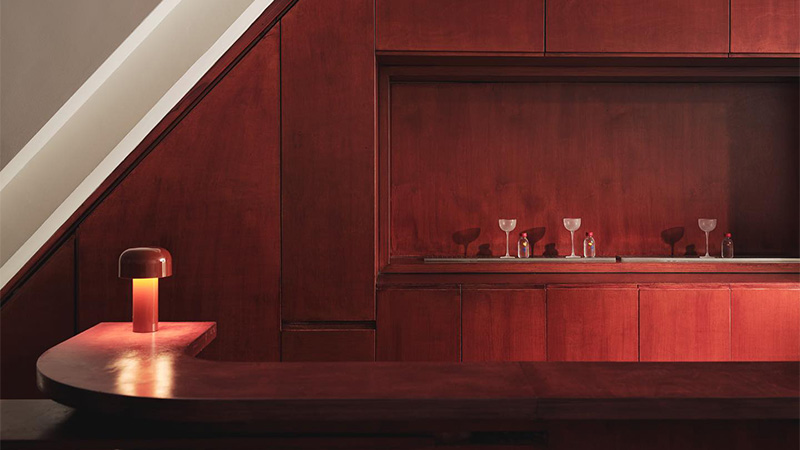
Focusing on Functionality
Many of the ways the modern bar is being rejiggered have more to do with logical functionality, and considerations such as ergonomics and efficiency. At Tayēr + Elementary in London, back room Tayēr features a U-shaped counter around a central station that was designed from the ground up with insight from founder Alex Kratena. And when starting from the ground up, Kratena knew he required something that extended higher off the ground than what is considered standard.
“You’ll notice that our work surfaces are taller than the industry norm, to accommodate for the fact that the average adult in the western world is significantly taller than hundreds of years ago,” Kratena says. “Staff work standing upright without bending over and ruining their lower back and posture.”
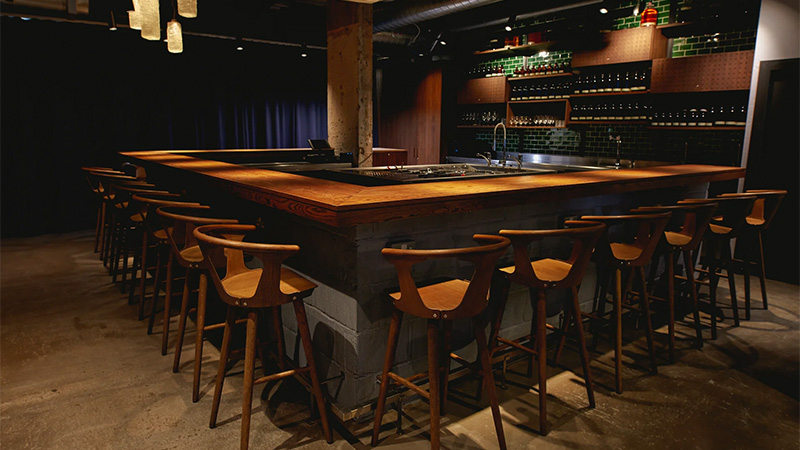
The bar stations are built to be kitchen-grade, with easy-to-clean and long-lasting stainless-steel components, with each station consisting of hexagonal components that can be used in myriad ways. “When standing upright, these perforated hexagons act as a work top, if you flick them upside down they act as a storage,” Kratena says. “Bartenders have at their disposal three types of inserts to build a station to the needs of the menu and season, but also to their individual preferences.”
Other features include drawers for garnishes, as well as refrigerated drawers for glassware filled with ice that could instead be set up to use as fridge or freezer units. Behind Bars Agency, which manufactured the setup, was nominated as a 2024 Créateurs Design Awards finalist for the project.
“The service is way quicker, as two bartenders are working in a mirrored space, sharing the drinks order-making, and cutting the making time by 70 percent.”
Its function-first central bar station is designed to boost productivity and guest experience, with stations operated in two-person teams consisting of a bartender and host. “Menu items are assigned to individual stations, meaning the whole night, each drink is prepped and executed by one person in the most consistent way possible,” Kratena says. “The host role ensures there is genuine hospitality with all the small details, while bartenders make sure they’re delivering the best drinks in the fastest manner.”
The team at Sips, meanwhile, says its bar cart does more than alter the vantage point and guest experience, also providing more efficient service. “The service is way quicker, as two bartenders are working in a mirrored space, sharing the drinks order-making, and cutting the making time by 70 percent,” Álvarez says.
A few blocks down the road in Barcelona is Galileo, where founder Andrea Civettini knew he wanted an adaptable bar that was built with his precise needs in mind, and worked with the Spanish group Cocktail Stations to get it done. “I measured the length of my arm,” he says. “No more problems with the back!”
His work station features sliding, grated covers over storage units for garnishes and tools, with deep bins holding several trays of ice in different forms. The bar is designed so that the guest’s portion of the counter extends at the same height as the bartender’s working area, as opposed to dropping off to a lowered well or hidden station. “We wanted to do something to be at the same level with the customer,” Civettini says. Guests get a good view of the process, while staff enjoy a versatile setup with improved ergonomics.
Look at the Bartenders. They Are the Captains Now
While a greater number of noted bars are now throwing tradition out the window to create different and dynamic spaces, it’s not a brand-new concept. Civettini says he was inspired by The Old Man in Singapore, and the first bar I remember seeing that flipped the script to such a great degree was The Old Man‘s original locale in Hong Kong, which opened in 2017. Founder Agung Prabowo designed a space with an I-shaped bar counter, with bartenders at the top of the capital I — in front of the now famous mosaic mural of Ernest Hemingway — and guests lining each of the other sides.
Prabowo drilled down to the most devilish of details, taking steps such as measuring the height of the countertops in Starbucks in an effort to divine factors that might lead guests to be comfortable and stay for a longer time (103 centimeters), and installing an ice-cold copper strip lining the counters for guests to rest their glasses, keeping drinks cold. The Old Man reopened after Prabowo and his team moved onto other projects and is now run by Nikita Matveev.
“When it comes to bar design, listen to the bartenders.”
At Gen Yamamoto, which has now been open for more than a decade in Tokyo, cocktail making is performance theater. There is no back bar, and for that matter, no bar back to provide assistance. There is no music playing and no artwork on the walls. There is Gen Yamamoto, making you drinks. Guests book seatings for seasonal, omakase cocktail tasting menus, grabbing one of eight seats at an L-shaped bar constructed from two thick slabs of 500-year-old Mizunara oak. His workstation behind the counter is recessed, leaving him at eye level with guests as he offers one elegant drink preparation after another.
Tayēr also features a label- and branding-free back bar, while prepping a lineup of produce-driven cocktails that changes by the day. “The choices of what products we carry are dictated by seasons, availability, and creativity of the R&D team,” Kratena says. “Corporate deals or listings don’t work for us.”
Kratena points to a few of the favorite concepts he’s seen elsewhere around the world, including Byrdi in Melbourne, Sakurai in Tokyo, Kink in Berlin, Room by Le Kief in Taipei, and Uni in Lisbon. “It’s important that the industry continues to evolve and explore and innovate, and it is fine to make mistakes on the way, otherwise we would still be using typewriters to write our recipes, and instead of iPhones we would use telegrams,” he says.
Rather than sticking with conventions for the sake of it, bartenders are now seizing control of their bars for themselves. Whether it’s in order to change the guest experience, provide a more ergonomic environment for bartenders, increase efficiency, or turn cocktail venues into conceptual art shows. Even — perhaps especially — if it means removing the bar in the process.
“When it comes to bar design, listen to the bartenders,” Caporale says.
This story is a part of VP Pro, our free platform and newsletter for drinks industry professionals, covering wine, beer, liquor, and beyond. Sign up for VP Pro now!
